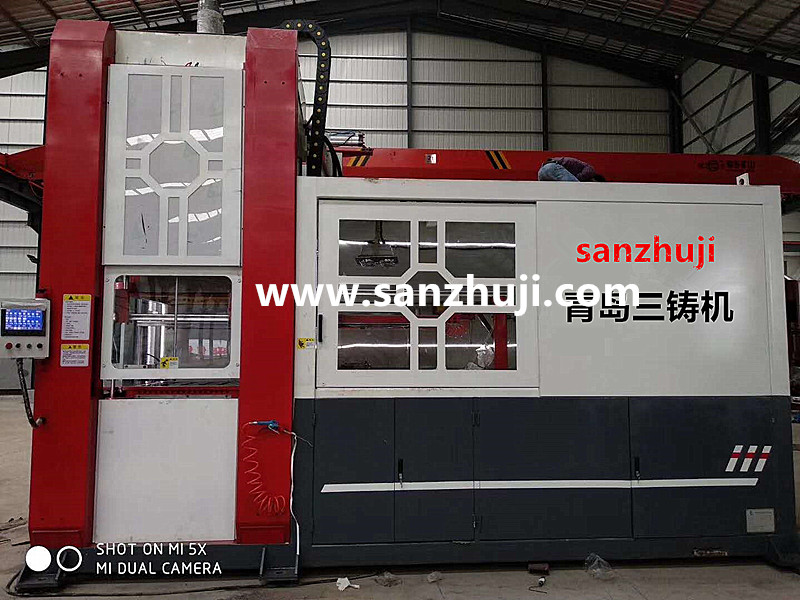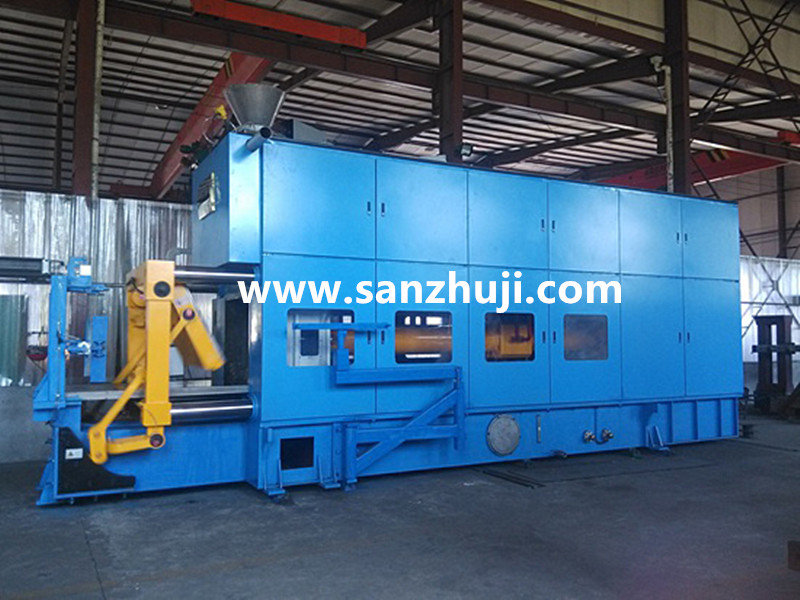In recent years, combining the production output of sand casting equipment and the cost of sand casting, green sand casting still occupies the mainstream. In the green sand casting process, the cooling and regeneration of old sand is a very critical process. Hot sand has been recognized as the number one factor in defects-related problems. Most foundries can clarify the direct relationship between the use of hot sand and the deterioration of casting quality. Sanzhuji combined with the foundry research shows that if the hot sand is not properly controlled, every major process of the entire casting production line will be affected. When using hot sand molding, the composition of hot molding sand, the quality of castings, and the problems encountered in production. In addition, the technology and key parameters in the cooling process of hot sand and the effect of controlling sand temperature are comprehensively considered.
Hot molding sand is defined as any high temperature sand that adversely affects the preparation, molding and casting quality of molding sand. Specifically, it refers to the recycled sand with a temperature of 49 ℃ ~ 71 ℃, whose heat is enough to cause the inhomogeneity of sand mixing and control problems. Sand above 71 ℃ cannot achieve uniform physical properties when sand is mixed. But sand below 49 ℃ can be mixed evenly. For the sand of 49 ℃ ~ 71 ℃, the sand after mixing is not uniform and difficult to control, and the sand that is fully mixed and below 49 ℃ is the best.
Comparing the viscosity of bentonite binder under different temperature and time conditions, the dispersion and condensation of bentonite in hot water and in cold water are different. The viscosity of bentonite increases with the increase of the temperature of the adhesive. Assume that when the glue liquid temperature increases, the thin layer of bentonite suspension particles arrange themselves from the edge to the middle, formed a kind of open structure, the structure and the state of the cold water is bonded liquid ratio, the thin layer of bentonite suspension particles remain face to face arrangement situation is very different, with the increase of temperature will form the open structure, which can lead to some negative effects on the sand system. On top of that, bentonite in hot sand is less able to hold water than cold sand, making it more likely to lose water and degrade physical properties. When hot sand is used, hot metal is poured into hot sand mold, and defects related to high water content of sand are produced, while defects related to low water content of sand are produced when hot sand mold is cooled and then poured into hot metal.
Sanzhuji works with the foundry in a closed temperature and humidity controlled room at 21 ° C and 60 ° C, respectively. All conditions remain the same except the temperature change of the molding sand. The molding sand is tested at 60 ° C, and its performance is significantly reduced. All process studies and data collected to date clearly define the critical temperature of tidal molding sand as 49 ° C (120υ).
Problems related to hot sand
Hot sand affects every aspect of the molding work of wet sand and leads to high reject rate, increasing bentonite consumption and even completely losing control of the system. In terms of waste products, most of the defects related to molding sand, and molding sand temperature is too high corresponding to each other, these defects include sand inclusion, surface roughness, metal infiltration, bulging, sticky sand, pinholes formed by gas, pores, fleshy and mold damage. Many of these defects are caused by the rapid loss of moisture from the mold surface.
In terms of sand treatment system operation
1. Hot sand has a tendency to stick to the cooler hopper and the wall of the hopper and form a hopper shrinkage tube. When hot sand enters the top of the hopper, it directly passes through the shrinkage tube in the middle of the hopper. The result is that only a small fraction of the system sand provided is used frequently. The problem of hot sand is exacerbated by the rapid increase in sand turnover due to the lack of active sand in the system, which raises the temperature of the sand.
2. Cold core placed in the hot cavity. Excessive moisture on the core surface can reduce core strength and produce casting defects, such as gas related pores and pinholes. Metal foundry workers may also experience problems due to condensation, such as molding sand sticking to the mold.
To maintain the stability of the sand system and reduce the fluctuation and change, this requires not only the balance of output and input materials, but also the balance of energy. New raw materials must be added to ensure that there is enough energy to make the clay in the sand mixer react. The heat generated by the solidification of the casting must be removed from the sand in order for the system to maintain an energy balance.
The temperature, moisture, particle size, clay content and other key physical properties of the recycled sand from the fallen sand will fluctuate. The mismatch between old Sand and new Sand is a problem for Sand mixer whether it is controlled automatically or manually. Ideally, a sand cooling system blends sand with different temperatures and other incompatible properties into a uniform sand. After the casting is sanded, the sand is mixed in an appropriate way. System sand (due to homogenization) will change gradually over time rather than in unexpected abrupt ways. However, simply adding water to the hot sand does not effectively cool the sand to produce a uniform molding. In order to cool effectively, the water must have enough time to contact all the sand particles. At the same time, efforts must be made to remove the vapor formed by the change of water from liquid to gas. For both reasons, watering sand on a conveyor belt does not effectively cool sand below 49 ° C.
It is important to emphasize that if the mixture of hot sand and water is saturated with humidity in the surrounding air, no vaporization will occur. In order for the sand cooling system to carry out vaporization cooling effectively, it is necessary to inject unsaturated air which can absorb water. Since it is ineffective to pass unsaturated air to the top of a damp sand clump, it is best to pass unsaturated air into the interior of the sand clump. Another major consideration for molding sand cooling is the stagnation time in the sand cooler. If the vapor is effectively removed by unsaturated air, the sand can be rapidly cooled to 100 ° C by continuous water vaporization. To get the sand temperature below 100 ° C, the cooling time will be extended and the process will no longer be instantaneous. Effective measures are that the sand cooling system must be able to provide sufficient unsaturated air and allow sufficient stagnation time of the sand in the cooling vessel to take full advantage of water vaporization and drying.
To vaporize the hot sand, water must be added, but only in a narrow range. The amount of water should be appropriate, that is, it helps to cool and strictly control the moisture of sand, so that the moisture of sand is close to the percentage needed for modeling as far as possible. In addition, when possible, it may be helpful to add some or all of the required bentonite to the sand cooling system. Due to the homogenization in the silo, the addition of water and bentonite at this stage is useful to improve system efficiency.
Strictly controlling the effective homogenization of moisture and sand in the system has a positive effect on ensuring the homogeneity of spare sand delivered to the molding process. Effective mixing and control of falling sand temperature and moisture prior to sand mixing will increase the ability of compactness control devices on the production line.
The above is the solution of hot sand cooling recovery in the process of green sand casting. Qingdao Sanzhuji Equipment Manufacturing Co., Ltd. specializes in the production of sand reclamation equipment, Sand casting equipment, Sand mixer, no-bake resin sand mixer, molding machine, foundry molding machine, flaskless moulding machine, shot blasting machine, dust collector, according to the amount of old sand recovered Carry out plan customization, and provide sand reclamation equipment installation, commissioning, and training. Welcome guests to visit the factory
Qingdao Sanzhuji Equipment Manufacturing Co., Ltd. specializes in the production of sand reclamation equipment,foundry machines,Sand casting equipment,GS high efficiency rotary mixer,no-bake resin sand mixer,Jolt squeeze molding machine/Jolt-squeezing moulding machines,Multi- Piston Moulding Machine/Hydraulic multi-piston moulding machine,foundry molding machine,flaskless moulding machine,shot blasting machine,dust collector,according to the amount of old sand recovered Carry out plan customization, and provide sand reclamation equipment installation, commissioning, and training. Welcome guests to visit the factory.








